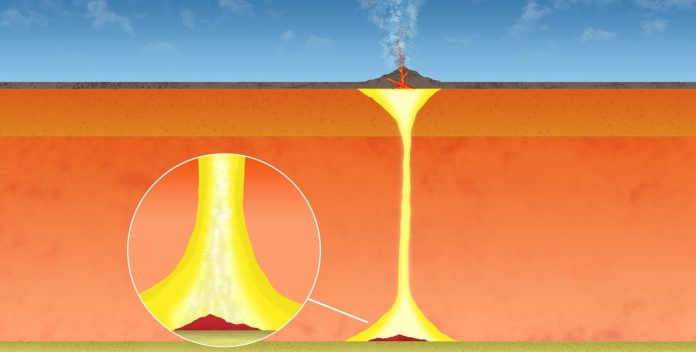
Deep inside our planet, at the core-mantle boundary (CMB), conditions are incredibly harsh—with temperatures soaring to thousands of degrees Fahrenheit and pressures a million times greater than at the Earth’s surface.
This extreme environment has puzzled scientists for years, particularly regarding its influence on the surface world where we live.
Scientists have long used seismic waves, which are generated by earthquakes, to explore what lies beneath Earth’s surface.
These waves move at different speeds depending on the material they pass through, similar to how sound waves in an ultrasound provide images of the human body.
Research has revealed that the base of the Earth’s mantle is complex and diverse. This was highlighted by the discovery of ultralow velocity zones (ULVZs), areas where seismic waves slow down significantly.
These zones, found about 3,000 kilometers below the surface, are thick, mountain-like regions, but their composition and nature have long been a mystery.
Jennifer Jackson, a professor at Caltech, has been at the forefront of this research. She and her team proposed in 2010 that these slow-wave regions might contain a higher concentration of iron oxide than the surrounding mantle.
The question was: could iron oxide remain solid in the CMB’s extreme conditions?
A new study led by Jackson’s team, including former Caltech graduate student Vasilije Dobrosavljevic, provides strong evidence that iron oxide can indeed stay solid at the extreme temperatures and pressures of the CMB.
They used advanced techniques like Mössbauer spectroscopy and X-ray diffraction to observe the behavior of iron atoms at these extreme conditions.
After conducting numerous experiments, the researchers found that iron oxide melts at temperatures above 4,000 Kelvins (around 6,700 degrees Fahrenheit)—much higher than previously thought.
This finding suggests that solid iron-rich regions in the Earth’s mantle could explain the mysterious ULVZs.
An unexpected discovery was made about atomic defects in iron materials. Typically, samples of iron oxide have tiny, regularly spaced defects in their atomic structure.
The behavior of these defects under high-pressure and high-temperature conditions, like those at the CMB, was unclear until now.
The team discovered that before iron oxide melts, these atomic defects become disordered at lower temperatures. This disordering of defects might have been mistaken for melting in earlier experiments.
This discovery opens new avenues of research into the physical properties of iron-rich regions in the Earth’s deep interior.
Understanding how these defects affect heat transport and material deformation is crucial for comprehending planetary dynamics, including the formation of upwelling plumes that can reach the Earth’s surface.
The findings from this study not only provide insights into the composition and behavior of materials in the Earth’s deep interior but also pave the way for future research.
Scientists are now keen to explore how these discoveries impact our understanding of the Earth’s evolution and the dynamic processes that shape our planet.
In summary, this study offers significant clues about the enigmatic core-mantle boundary and its solid iron-rich regions, shedding light on one of the Earth’s most inaccessible yet influential parts.



